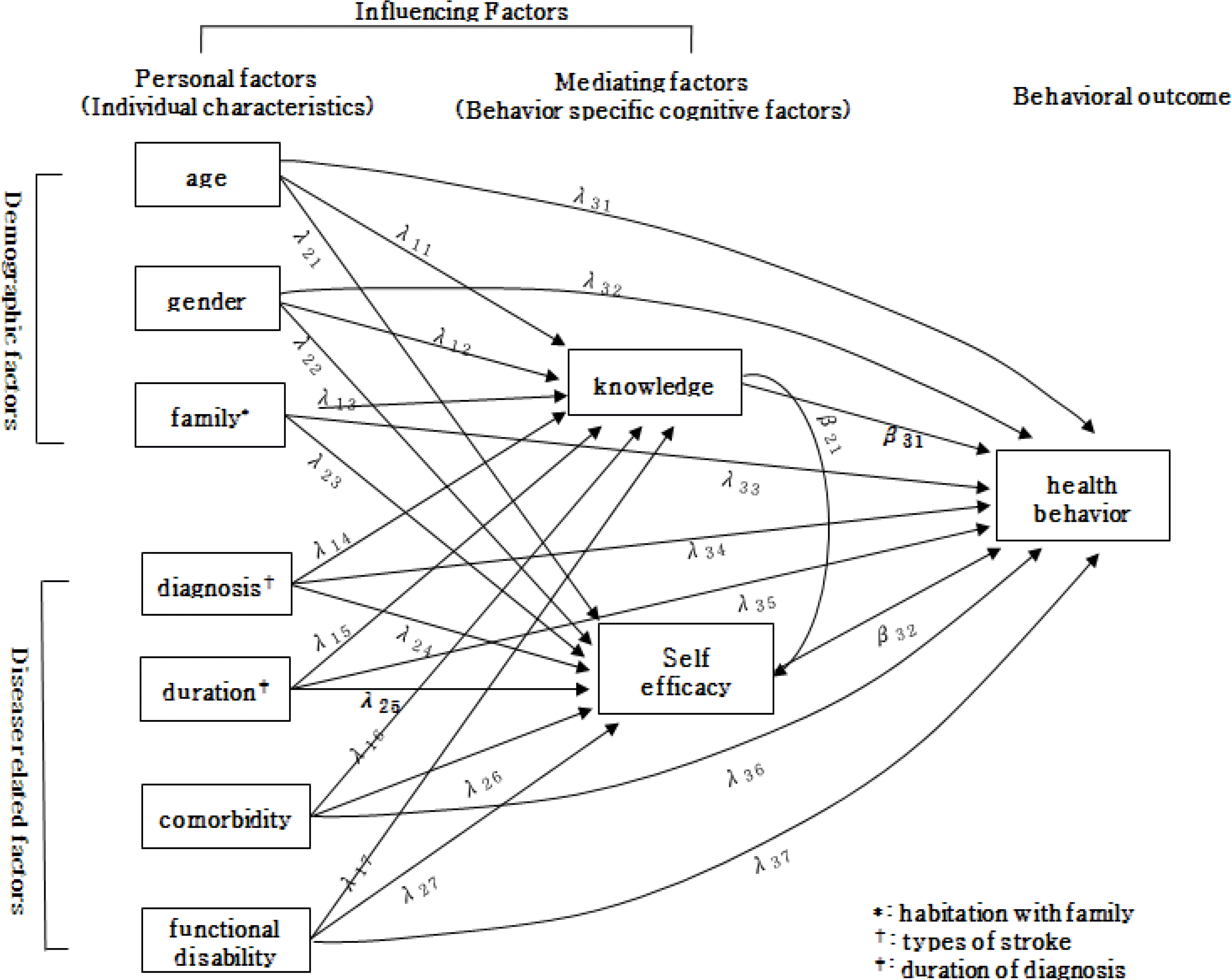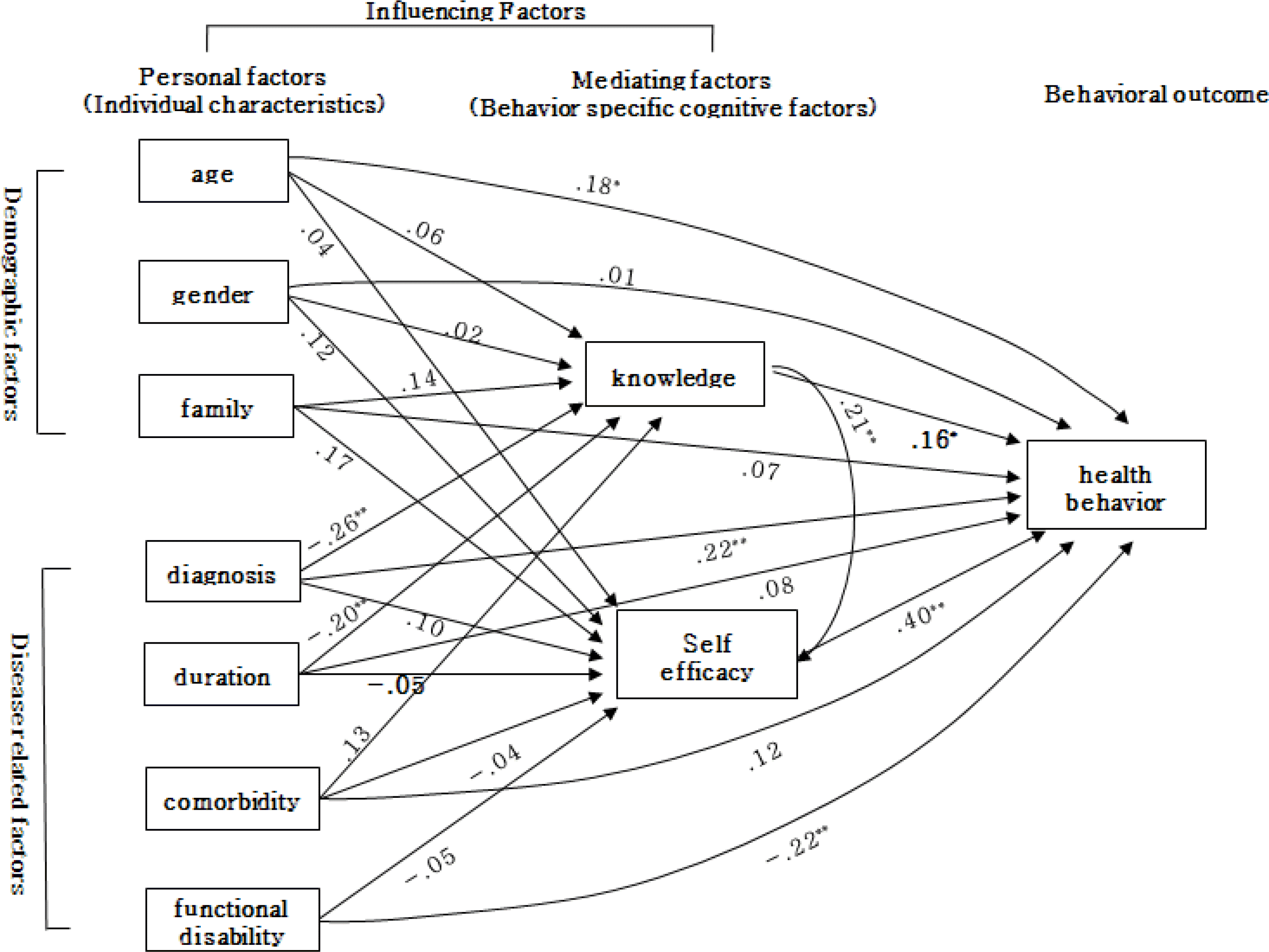Abstract
Purpose
The study was designed to identify influencing and mediating factors of health behaviors of stroke patients based on the hypothetical model constructed in this study.
Methods
Non-experimental correlational research design was used. One hundred and five stroke patients were conveniently selected from one university hospital located in Incheon. Data were collected with survey and analyzed by path analysis to examine the significant influencing and mediating factors of health behaviors in stroke patients.
Results
Age, diagnosis, disability in ADL, knowledge related to health behavior, and self-efficacy had significant direct causal influences on health behavior. And it was shown that knowledge and self-efficacy mediated influence of cohabitation status with family(whether or not living together with family) on health behavior. Self-efficacy also mediated influence of knowledge on health behavior.
Conclusion
From the results, it was proposed that providing knowledge related to health behavior and enhancing self-efficacy by educating skill necessary for health behaviors and promoting health related beliefs might increase health behavior particularly for stroke patients living together with family.
REFERENCES
Bak H. K.2003. The effects of the stroke secondary prevention program on the health-promoting lifestyle and the health risk indicators of the in-house stroke patient. Unpublished doctoral dissertation, Korea University, Seoul.
Chang M. K.2004. The knowledge and educational needs of stroke in the elderly. Unpublished master's thesis, Ewha Womans University, Seoul.
Chao J.., Nau D. P.., Aikens J. E.., Taylor S. D.2005. The mediating role of health beliefs in the relationship between depressive symptoms and medication adherence in persons with diabetes. Research in Social & Administrative Pharmacy. 1(4):508–525.

Cheung C. M.., Tsoi T. H.., Hon S. F.., Au-Yeung M.., Shiu K. L.., Lee C. N., et al. 2007. Outcomes after first-ever stroke. Hong Kong Medical Journal. 13(2):95–99.
Choi E. H.2012. Structural equation modeling of health behaviors in patients with coronary artery disease based on the coping model of chronic illness. Unpublished doctoral dissertation, Seoul National University, Seoul.
Clinical Research Center for Stroke. 2009. Work introduction. Re- trieved January 3, 2011, from. http://www.stroke-crc.or.kr.
Cohen J.1988. Statistical power analysis for the behavioral science. 2nd ed.New Jersey: Lawrence Erlbaum Association, Inc.
Ji R.., Liu G.., Shen H.., Wang Y.., Li H.., Peterson E., et al. 2013. Persistence of secondary prevention medications after acute ischemic stroke or transient ischemic attack in Chinese population: Data from China National Stroke Registry. Neurological Research. 35(1):29–36. http://dx.doi.org/10.1179/1743132812Y.0000000107.

Jin H.., Zhu S.., Wei J. W.., Wang J.., Liu M.., Wu Y., et al. 2012. China QUEST (Quality Evaluation of Stroke Care and Treatment) Investigators. Factors associated with prehospital delays in the presentation of acute stroke in urban China. Stroke. 43(2):362–370. http://dx.doi.org/10.1161/STROKEAHA.111.623512.
Kim M. H.., Lee D. H.2011. Analysis of factor of relationship between senior citizens' health promotion behavior and chronic disease. Journal of Korean Society for Health Education and Promotion. 28(2):99–107.
Kokubo Y.2012. Traditional risk factor management for stroke: A never-ending challenge for health behaviors of diet and physical activity. Current Opinion in Neurology. 25(1):11–17. http://dx.doi.org/10.1097/WCO.0b013e32834eb58e.
Korean Neurological Association. 2005. Neurologic signs and symptoms, and disease. Retrieved April 28, 2011, from. http://www.neuro.or.kr.
Korean Neurosurgical Society. 2008. Neurosurgery. 4th ed.Seoul: The Korean Neurosurgical Society.
Korean Stroke Society. 2005. Database. Retrieved February 02, 2011, from. http://www.stroke.or.kr.
Lawrence M.., Kerr S.., McVey C.., Godwin J.2012. The effectiveness of secondary prevention lifestyle interventions designed to change lifestyle behavior following stroke: Summary of a systematic review. International Journal of Stroke. 7(3):243–247. http://dx.doi.org/10.1111/j.1747-4949.2012.00771.x.

Lee E. J.2011. A study on the knowledge of stroke and health promoting behaviors of transient ischemic attack (TIA) patients. Unpublished master's thesis, Gyeongsang National University, Jinju.
Lee H. R.2010. Health knowledge of stroke, health promoting behavior and health risk indicators of stroke patients in a university hospital. Unpublished master's thesis, Inha University, Incheon.
Lee J. J.., Choo I. S.., Kim H. W.., Kim J. H.., Ahn S. H.2009. Influence of stroke knowledge on prehospital delay of acute ischemic stroke patients. Journal of Korean Neurological Association. 27(2):123–128.
Lee M. S.2004. Relating factors and health promoting beha viors of stroke patients. Unpublished master's thesis, Catholic University of Pusan, Busan.
Min S. H.., Kim J. I.2012. Construction of explanatory model for medication adherence in older people with chronic disease. Journal of Korean Academy of Fundamentals of Nursing. 19(4):463–473. http://dx.doi.org/10.7739/jkafn.2012.19.4.463.

Moos R. H.., Holahan C. J.2007. Adaptive tasks and methods of coping with illness and disability. Martz E., Livneh H., editorsCoping with chronic illness and disability. p. 107–126. New York: Springer.

Oh H. S.1993. Health promoting behaviors and quality of life of Korean women with rheumatoid arthritis. Unpublished doctoral dissertation, The University of Texas at Austin, Austin.
Oh H. S.., Park H. A.2006. Decision-tree model of treatment-seeking behaviors after detecting symptoms by Korean stroke patients. Journal of Korean Academy of Nursing. 36(4):662–670.

Park S. I.., Cho B. H.2004. A study on the activities fo daily living, self-efficacy and the health promoting behavior in stroke patients. The Korean Journal of Rehabilitation Nursing. 7(2):149–158.
Pender N. J.., Murdaugh C. L.., Parsons M. A.2002. Health promotion in nursing practice. 4th ed.New Jersey: Prentice Hall.
Rehe R. H.., Scalzi C.., Shine K.1975. A teaching evaluation questionnaire for post myocardial patients. Heart & Lung. 4(5):759–766.
Song H.., Oh H.., Kim H.., Seo W.2010. Effects of a sexual rehabilitation intervention program on stroke patients and their spouses. NeuroRehabilitation. 28(2):143–50. http://dx.doi.org/10.3233/NRE-2011-0642.

Walker S. N.., Sechrist K. R.., Pender N. J.1987. The health promoting lifestyle profile: Development and psychometric characteristics. Nursing Research. 36(2):76–81.
Wan L. H.., Zhao J.., Zhang X. P.., Deng S. F.., Li L.., He S. Z., et al. 2013. Stroke prevention knowledge and prestroke health behaviors among hypertensive stroke patients in mainland China. Journal of Cardiovascular Nursing. http://dx.doi.org/10.1097/JCN.ob013e31827foab5.

Woo Y. S.., Yu Y. G.., Choi I. S.., Seo S. H.., Jung J. W.., Li L., et al. 2003. The Study of the recurrence rate within one year following a secondary prevention of CVA(Cerebro-vascular Accident). The Journal of Korean Oriental Internal Medicine. 24(4):778–791.
Wu Y.., Zhang L.., Yuan X.., Wu Y.., Yi D.2011. Quantifying links between stroke and risk factors: A study on individual health risk appraisal of stroke in community of Chongqing. Neurological Science. 32(2):211–219. http://dx.doi.org/10.1007/s10072-010-0333-2.
Figure 1.
Hypothetical model for influencing and mediating factors of health behavior of stroke patients.

Table 1.
Descriptive Statistics of Subjects' Characteristics (N=105)
Table 2.
Parameters Estimates of the Hypothetical Model of Influencing and Mediating Factors of Health Behavior for Stroke Patients
| Extrinsic | Intrinsic factors | Coefficient estimates | SMC | ||
|---|---|---|---|---|---|
| Direct (T-value) | Indirect (T-value)† | Total (T-value) | |||
| Knowledge related to health | Age | .06 (0.50) | - | .06 (0.50) | .11 |
| Gender‡ | .02 (0.24) | - | .02 (0.24) | ||
| Living together with family§ | .14 (1.34) | - | .14 (1.34) | ||
| Diagnosis|| | -.26 (-2.59)∗∗ | - | -.26 (-2.59)∗∗ | ||
| Duration of illness | -.20 (-1.98)∗∗ | - | -.20 (-1.98)∗∗ | ||
| Comorbidity¶ | .13 (1.21) | - | .13 (1.21) | ||
| Self-efficacy | Age | .04 (0.36) | .01 (0.49) | .05 (0.46) | .10 |
| Gender | .12 (1.19) | .01 (0.24) | .13 (1.21) | ||
| Living together with family | .17 (1.55) | .03 (1.14) | .20 (1.81)∗ | ||
| Diagnosis | .10 (0.98) | -.05 (-1.61) | .05 (0.46) | ||
| Duration of diagnosis | -.05 (-0.51) | -.04 (-1.45) | -.09 (-0.91) | ||
| Comorbidity | -.04 (-0.39) | .03 (1.05) | -.01 (-0.14) | ||
| Functional disability | -.05 (-0.52) | - | -.05 (-0.52) | ||
| Knowledge related to health | .21 (2.13)∗∗ | - | .21 (2.13)∗∗ | ||
| Health behavior | Age | .18 (1.89)∗ | .03 (0.56) | .21 (1.93)∗ | .36 |
| Gender | .01 (0.03) | .05 (1.11) | .06 (0.57) | ||
| Living together with family | .07 (0.71) | .10 (1.90)∗ | .17 (1.61) | ||
| Diagnosis | -.22 (-2.46)∗∗ | .02 (0.42) | .20 (2.02)∗∗ | ||
| Duration of illness | .08 (0.87) | -.07 (-1.37) | .01 (0.08) | ||
| Comorbidity | .12 (1.30) | .01 (0.28) | .13 (1.29) | ||
| Functional disability | -.22 (-2.58)∗∗ | -.02 (-0.52) | -.24 (-2.56)∗∗ | ||
| Knowledge related to health | .16 (1.84)∗ | .08 (1.95)∗ | .24 (2.61)∗∗ | ||
| Self-efficacy | .40 (4.79)∗∗ | - | .40 (4.79)∗∗ | ||




 PDF
PDF ePub
ePub Citation
Citation Print
Print



 XML Download
XML Download